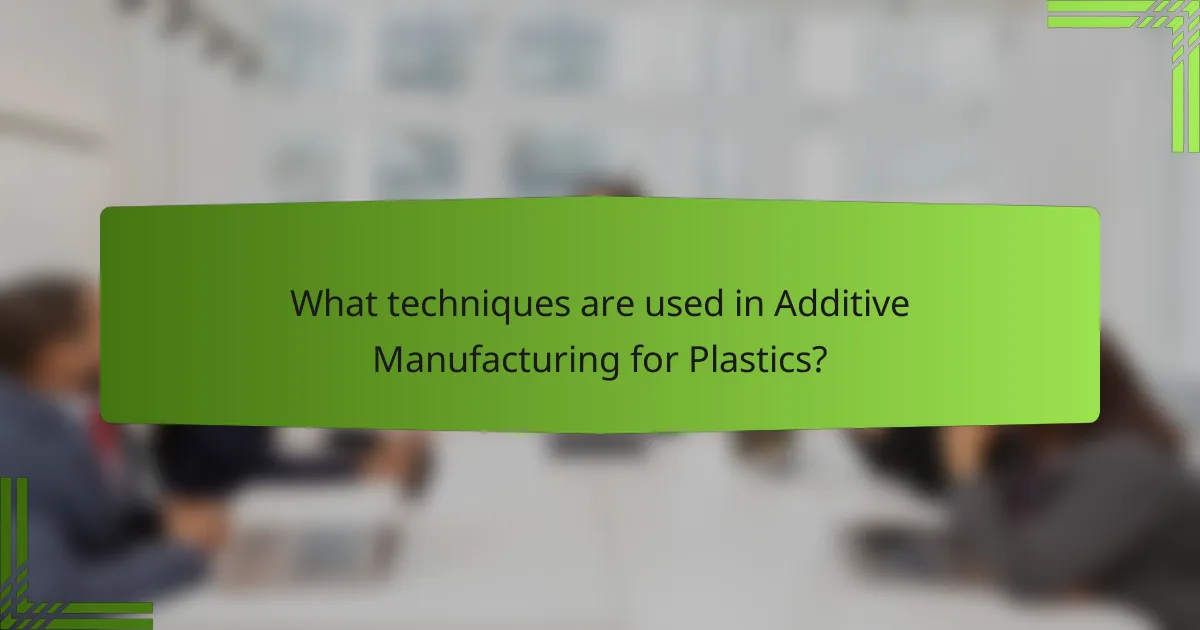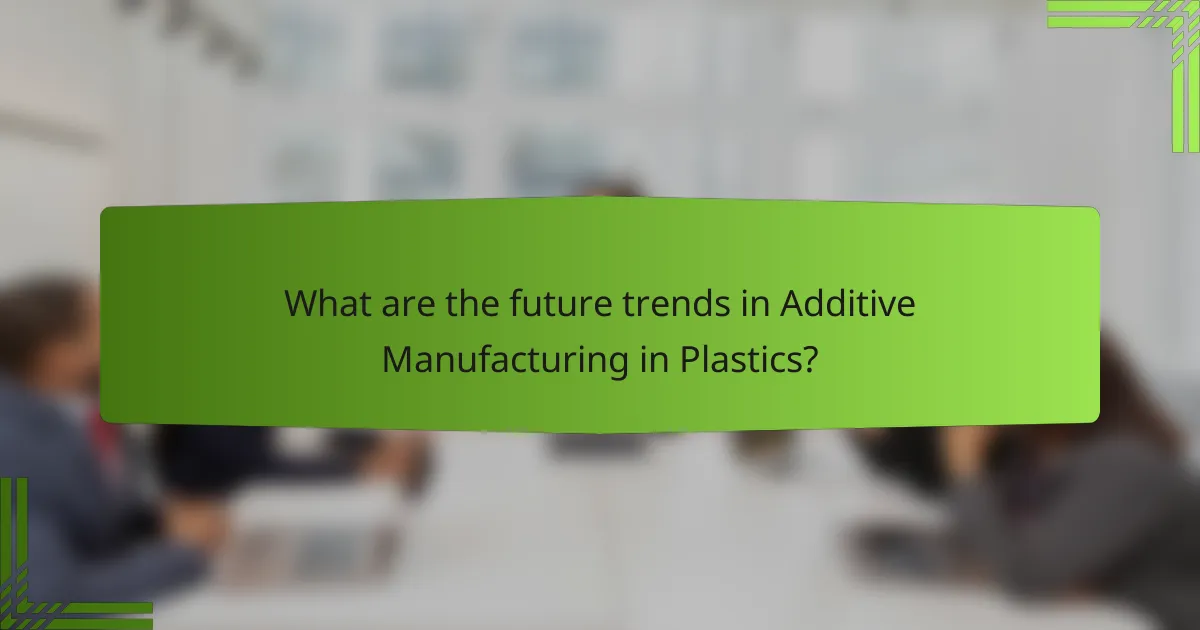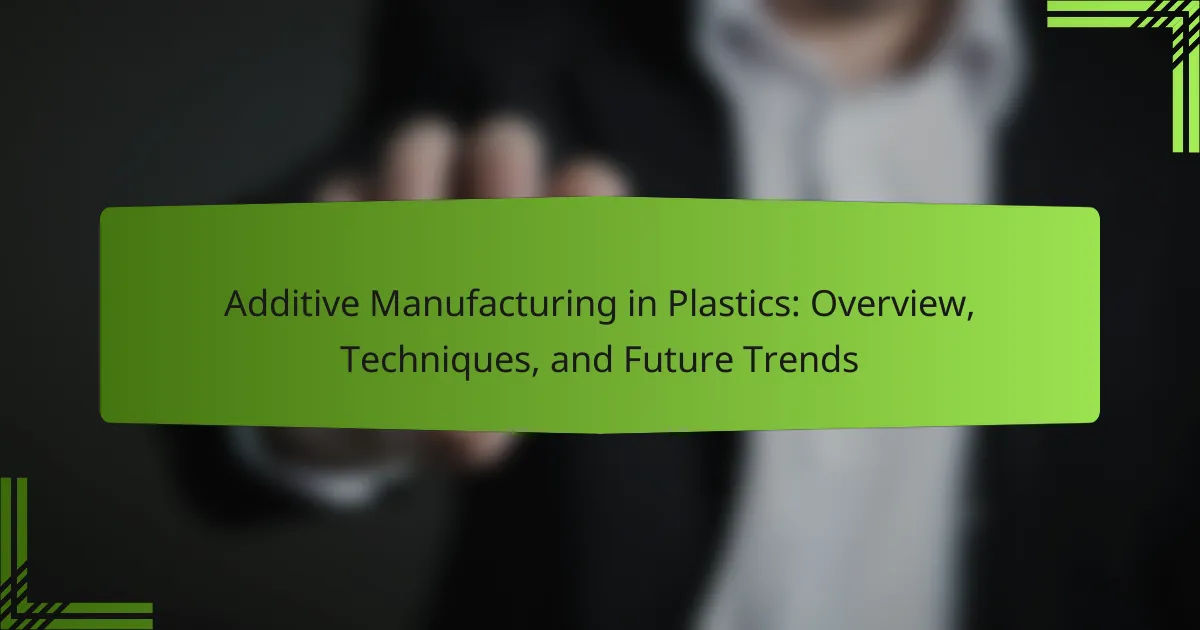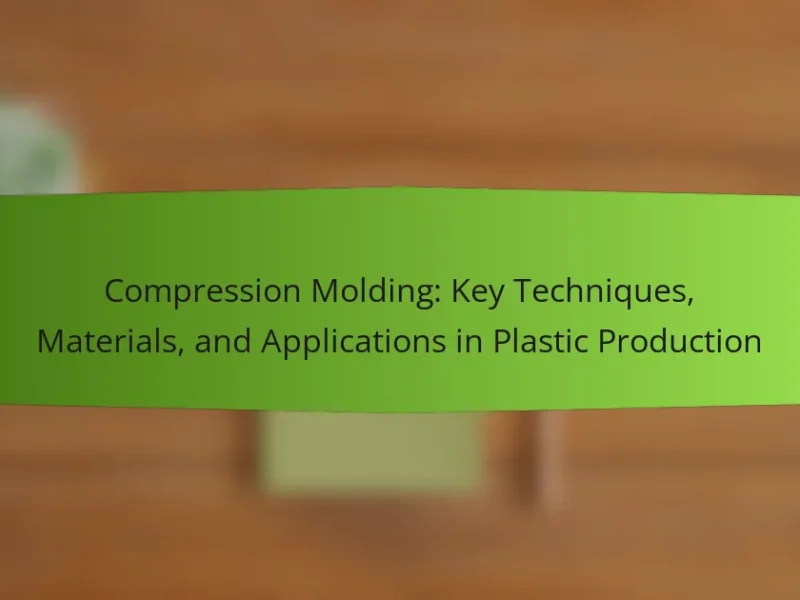Additive manufacturing in plastics is a process that creates three-dimensional objects by layering plastic materials, utilizing techniques such as Fused Deposition Modeling (FDM), Stereolithography (SLA), and Selective Laser Sintering (SLS). This technology allows for the production of complex geometries and customized designs, contributing to a rapidly growing market valued at approximately $1.3 billion in 2021. Key techniques each offer distinct advantages: FDM is cost-effective for prototyping, SLA excels in precision and surface finish, and SLS is ideal for functional parts. Future trends indicate increased material diversity, enhanced printing speeds, and a focus on sustainability, with ongoing advancements in technology and integration with artificial intelligence driving the evolution of additive manufacturing in plastics.

What is Additive Manufacturing in Plastics?
Additive manufacturing in plastics refers to a process of creating three-dimensional objects by layering plastic materials. This technique builds parts from digital models using methods like fused deposition modeling (FDM) and selective laser sintering (SLS). Each layer of plastic is deposited or fused together to form a solid object. This method allows for complex geometries and customization in design. According to a 2021 report by Wohlers Associates, the additive manufacturing market for plastics reached approximately $1.3 billion. This growth highlights the increasing adoption of this technology across various industries.
How does Additive Manufacturing in Plastics differ from traditional manufacturing methods?
Additive Manufacturing in Plastics differs from traditional manufacturing methods primarily in its layer-by-layer construction process. Traditional manufacturing typically involves subtractive techniques, such as machining or molding, which remove material to create an object. In contrast, Additive Manufacturing builds objects by adding material, allowing for complex geometries and reduced waste.
This method enables rapid prototyping and customization, as designs can be easily altered in digital formats. According to a report by Wohlers Associates, the additive manufacturing market is projected to grow significantly, highlighting its increasing adoption. Moreover, Additive Manufacturing often requires less tooling and setup time compared to traditional methods, enhancing production efficiency.
What are the key characteristics of Additive Manufacturing in Plastics?
Additive manufacturing in plastics is characterized by layer-by-layer material deposition. This process allows for complex geometries that traditional manufacturing cannot achieve. It enables customization and rapid prototyping. The technology is often cost-effective for small production runs. Materials used include thermoplastics and photopolymers. Each layer is precisely controlled for accuracy. The process generates less waste compared to subtractive manufacturing. Additionally, it supports the integration of multiple materials in a single print.
Why is Additive Manufacturing in Plastics gaining popularity?
Additive Manufacturing in Plastics is gaining popularity due to its ability to create complex designs efficiently. This technology allows for rapid prototyping and reduces material waste. It enables customization and flexibility in production processes. According to a report by Wohlers Associates, the additive manufacturing market is expected to grow significantly, reaching $21 billion by 2024. The versatility of materials used in plastic additive manufacturing contributes to its appeal. Furthermore, industries like automotive and aerospace are increasingly adopting this technology for lightweight components. The ongoing advancements in 3D printing technologies enhance the quality and speed of production.
What are the main applications of Additive Manufacturing in Plastics?
The main applications of Additive Manufacturing in Plastics include prototyping, tooling, and production of end-use parts. Prototyping allows for rapid design iterations and testing. Tooling applications involve creating molds and fixtures efficiently. Production of end-use parts enables customized and complex geometries that traditional methods cannot achieve. According to a report by Wohlers Associates, the additive manufacturing market for plastics is growing significantly, indicating increased adoption across various industries.
Which industries are leveraging Additive Manufacturing in Plastics?
Additive Manufacturing in Plastics is leveraged by several key industries. The aerospace industry utilizes it for lightweight component production. The automotive sector employs this technology for prototyping and custom parts. Healthcare benefits from additive manufacturing for medical devices and prosthetics. Consumer goods companies use it for rapid prototyping and product development. The construction industry applies this technology for creating complex building materials. Each of these industries relies on the precision and customization that additive manufacturing offers.
How does Additive Manufacturing in Plastics impact product development cycles?
Additive manufacturing in plastics significantly accelerates product development cycles. It allows for rapid prototyping, enabling designers to create and test iterations quickly. Traditional manufacturing often involves lengthy tooling processes; additive manufacturing eliminates this step. This technology reduces lead times from weeks to days. It also minimizes material waste, making the process more efficient. According to a study by Wohlers Associates, additive manufacturing can reduce product development time by up to 70%. This efficiency leads to faster time-to-market for new products. Overall, additive manufacturing transforms how products are designed and produced, enhancing innovation and responsiveness in the market.

What techniques are used in Additive Manufacturing for Plastics?
Additive manufacturing for plastics utilizes several key techniques. These techniques include Fused Deposition Modeling (FDM), Stereolithography (SLA), and Selective Laser Sintering (SLS). FDM involves melting thermoplastic filaments and extruding them layer by layer. SLA uses a UV light source to cure liquid resin into solid plastic. SLS employs a laser to fuse powdered plastic materials into a solid structure. Each technique offers unique advantages for different applications. FDM is widely used for prototyping due to its cost-effectiveness. SLA provides high precision and smooth surface finishes. SLS allows for complex geometries and is ideal for functional parts.
What are the different types of Additive Manufacturing techniques for Plastics?
The different types of Additive Manufacturing techniques for Plastics include Fused Deposition Modeling (FDM), Stereolithography (SLA), Selective Laser Sintering (SLS), and Digital Light Processing (DLP). FDM involves melting plastic filament and extruding it layer by layer to create a part. SLA uses a laser to cure liquid resin into solid plastic, allowing for high-resolution prints. SLS employs a laser to fuse powdered plastic materials, resulting in strong and durable parts. DLP is similar to SLA but uses a digital light projector to cure the resin, speeding up the printing process. Each technique offers unique advantages and is suited for different applications in the field of additive manufacturing.
How does Fused Deposition Modeling (FDM) work in Additive Manufacturing?
Fused Deposition Modeling (FDM) is a 3D printing process used in additive manufacturing. It works by extruding thermoplastic filament through a heated nozzle. The nozzle melts the filament, allowing it to be deposited layer by layer. Each layer adheres to the previous one as it cools and solidifies. This process continues until the entire object is built. FDM is widely used due to its versatility and cost-effectiveness. It can produce complex geometries and is suitable for various applications, including prototyping and production parts. The technology is supported by numerous studies highlighting its efficiency and capabilities in manufacturing.
What advantages does Selective Laser Sintering (SLS) offer in Additive Manufacturing?
Selective Laser Sintering (SLS) offers several advantages in Additive Manufacturing. SLS enables the production of complex geometries that are difficult or impossible to achieve with traditional manufacturing methods. The process uses a laser to fuse powdered materials, allowing for high precision and detail in the final product. SLS is compatible with a wide range of materials, including nylon, which provides versatility in applications.
Additionally, SLS does not require support structures, as the unsintered powder supports the part during the build process. This feature reduces material waste and post-processing time. The SLS process also allows for rapid prototyping, significantly shortening the time from design to production. Finally, SLS parts exhibit excellent mechanical properties, making them suitable for functional testing and end-use applications.
What factors influence the choice of technique in Additive Manufacturing for Plastics?
The choice of technique in Additive Manufacturing for Plastics is influenced by several key factors. These include material properties, desired part geometry, production speed, and cost efficiency. Material properties dictate the compatibility of plastics with specific techniques. For example, some methods work better with thermoplastics, while others are suited for thermosetting plastics. Desired part geometry impacts the selection of techniques based on complexity and precision requirements. Production speed is critical for determining the suitability of a technique for high-volume manufacturing. Cost efficiency also plays a significant role, as different techniques have varying equipment and operational costs. Additionally, the intended application of the final product can influence the choice of technique. These factors collectively guide manufacturers in selecting the most appropriate additive manufacturing technique for their specific needs.
How do material properties affect the selection of Additive Manufacturing techniques?
Material properties significantly influence the selection of Additive Manufacturing techniques. Different materials exhibit unique characteristics such as strength, flexibility, and thermal stability. For example, thermoplastics are often chosen for their ease of processing and recyclability. In contrast, metals may be selected for applications requiring high strength and durability.
The melting point of a material determines the appropriate technique; for instance, Selective Laser Sintering (SLS) is suitable for materials with high melting points. The layer adhesion and surface finish also depend on the material’s properties. Materials with high viscosity may require specific extrusion techniques to ensure proper flow during printing.
Additionally, the intended application of the final product can dictate material choice. Functional prototypes may utilize different materials compared to end-use parts. Understanding these material properties helps engineers and designers make informed decisions in the Additive Manufacturing process.
What role does production volume play in choosing an Additive Manufacturing technique?
Production volume significantly influences the selection of an Additive Manufacturing technique. Higher production volumes typically require faster and more efficient methods. Techniques like Fused Deposition Modeling (FDM) may be suitable for low-volume production. However, for high-volume needs, technologies such as Selective Laser Sintering (SLS) or Multi Jet Fusion (MJF) are often preferred. These methods offer greater speed and scalability. According to a study by Wohlers Associates, production volume directly impacts cost-effectiveness and time efficiency in additive processes. Choosing the right technique based on production volume ensures optimal resource utilization and meets market demands effectively.

What are the future trends in Additive Manufacturing in Plastics?
Future trends in additive manufacturing in plastics include increased material diversity, enhanced printing speeds, and improved sustainability. Companies are developing new plastic materials that offer better mechanical properties and thermal resistance. Innovations in printing technology are reducing production times significantly. Sustainable practices are becoming a priority, with a focus on biodegradable materials and recycling processes. Integration with artificial intelligence is streamlining design and production workflows. Additionally, advancements in multi-material printing are enabling more complex designs. These trends are supported by ongoing research and development in the field, indicating a robust future for additive manufacturing in plastics.
How is technology evolving in Additive Manufacturing for Plastics?
Technology in Additive Manufacturing for Plastics is evolving through advancements in materials, processes, and software. New polymer formulations enhance the mechanical properties of printed parts. Innovations like multi-material printing allow for complex geometries and functions. Improved printing speeds and resolutions are being achieved with advanced nozzle designs. Software developments enable better simulation and optimization of the printing process. Integration of machine learning is improving quality control and defect detection. Research indicates that these advancements lead to increased efficiency and reduced costs in production. The market for additive manufacturing in plastics is projected to grow significantly, reflecting these technological improvements.
What innovations are expected to shape the future of Additive Manufacturing in Plastics?
Innovations expected to shape the future of Additive Manufacturing in Plastics include advanced materials, improved printing technologies, and enhanced software solutions. Advanced materials like bioplastics and composites will offer better performance and sustainability. Improved printing technologies, such as multi-material and high-speed 3D printing, will increase efficiency and design capabilities. Enhanced software solutions will optimize design processes and streamline production workflows. These innovations are driven by the need for customization, reduced waste, and faster production times in various industries. The integration of artificial intelligence and machine learning will further refine these processes, enabling smarter manufacturing solutions.
How will sustainability impact future trends in Additive Manufacturing?
Sustainability will significantly influence future trends in Additive Manufacturing (AM). The industry is shifting towards eco-friendly materials and processes. This includes the use of biodegradable plastics and recycled materials. Companies are focusing on reducing waste through efficient production techniques. Energy consumption in AM is also being optimized to lower carbon footprints. Research indicates that sustainable practices can enhance product lifecycle and reduce environmental impact. According to a study by the University of Cambridge, implementing sustainable AM can decrease energy use by up to 50%. As regulations tighten, businesses will prioritize sustainability to remain competitive.
What challenges does Additive Manufacturing in Plastics face moving forward?
Additive manufacturing in plastics faces several challenges moving forward. Material limitations restrict the range of properties achievable in printed parts. Many plastics used in additive manufacturing lack the strength and durability required for specific applications. Additionally, the variability in print quality can lead to inconsistencies in the final product.
Another challenge is the slow printing speed of current additive manufacturing technologies. This can hinder mass production capabilities compared to traditional manufacturing methods. The need for post-processing steps further complicates production timelines and costs.
Regulatory compliance presents another hurdle, especially in industries like aerospace and medical. Standards for material safety and performance are still evolving. Finally, the environmental impact of plastic waste generated during the additive manufacturing process is a growing concern. Addressing these challenges is crucial for the future advancement of additive manufacturing in plastics.
What are the common technical obstacles in Additive Manufacturing for Plastics?
Common technical obstacles in Additive Manufacturing for plastics include material limitations, thermal warping, and layer adhesion issues. Material limitations arise from the restricted range of polymers suitable for 3D printing. Thermal warping occurs due to uneven cooling rates during the printing process, leading to distortion. Layer adhesion issues can result from insufficient bonding between layers, affecting the structural integrity of the final product. These obstacles can hinder the quality and performance of printed parts. For instance, studies indicate that improper temperature settings can exacerbate these issues, impacting the overall success of additive manufacturing processes.
How can businesses overcome challenges in adopting Additive Manufacturing technologies?
Businesses can overcome challenges in adopting Additive Manufacturing technologies by investing in training and education. This ensures that employees understand the technology and its applications. Additionally, companies should conduct thorough research to identify suitable materials and processes for their specific needs. Collaborating with technology providers can also offer valuable insights and support.
Implementing pilot projects allows businesses to test the technology on a smaller scale before full adoption. Establishing clear goals and metrics for success is essential to measure progress. Companies can also seek funding or grants to offset initial costs associated with technology adoption.
According to a study by Wohlers Associates, 52% of companies reported that workforce skill gaps hindered their adoption of Additive Manufacturing. Addressing these gaps through focused training programs can significantly enhance adoption rates. Furthermore, a report from the Boston Consulting Group highlights that companies that invest in technology partnerships see a 30% faster implementation of new technologies.
What best practices should be followed for successful Additive Manufacturing in Plastics?
Successful Additive Manufacturing in Plastics requires precise control of process parameters. Key practices include optimizing temperature settings for different materials. Maintaining consistent feed rates is crucial to ensure uniform extrusion. Regular calibration of the printer enhances dimensional accuracy. Using high-quality filament minimizes defects and improves print quality. Proper bed adhesion techniques prevent warping during printing. Post-processing methods, such as sanding or painting, enhance the final product’s appearance. These practices lead to stronger, more reliable plastic components in various applications.
Additive manufacturing in plastics is a process that creates three-dimensional objects by layering plastic materials, utilizing techniques such as fused deposition modeling (FDM) and selective laser sintering (SLS). This article provides an overview of the differences between additive manufacturing and traditional manufacturing methods, highlighting its benefits like reduced waste, rapid prototyping, and customization. Key characteristics, applications across various industries, and future trends such as advancements in materials and sustainability are also discussed. Additionally, the article addresses the challenges faced in the adoption of additive manufacturing technologies and outlines best practices for successful implementation.


